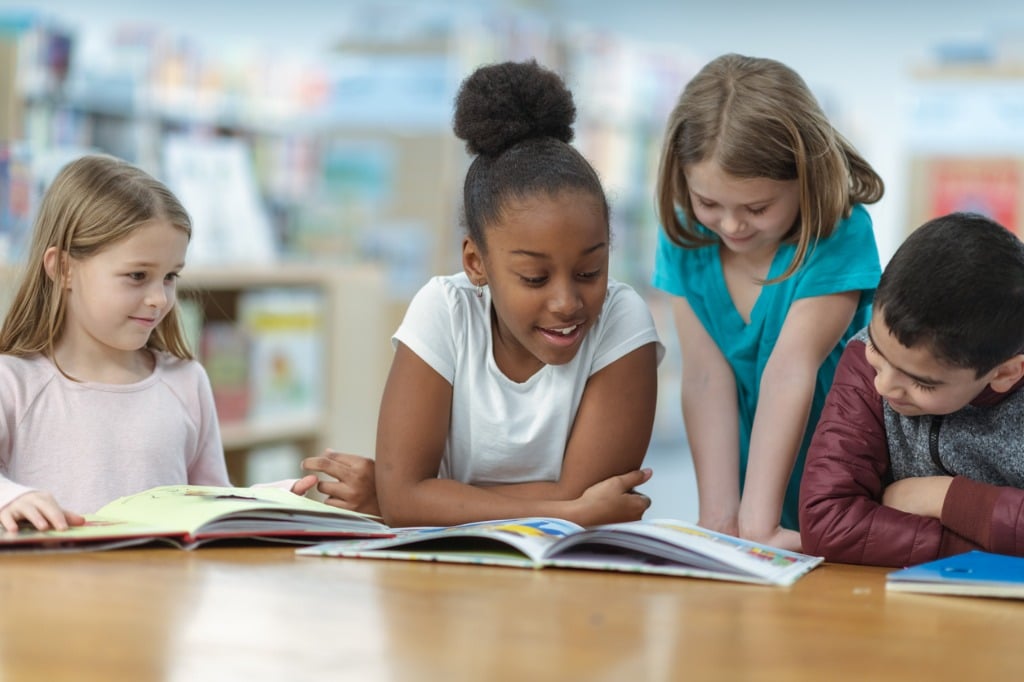Cloze Creative Writing Activities Third

Learning is better with laughter. Maybe it sounds a bit silly—after all, education is an important matter—but humor isn't just for fun; it actually motivates students to try harder in class!
As one American Psychological Association article illuminates, "when used effectively, classroom comedy can improve student performance by reducing anxiety, boosting participation and increasing students' motivation to focus on the material." In short, laughter helps students learn.
The good news is, humor is easy to inject into your lesson plans to make writing more fun for your students. These giggle-worthy 3rd grade writing activities encourage humor in the classroom (and in your students' writing ) without forcing you to tell a single knock-knock joke—unless you want to, of course!
Writing Activity #1: Fun With Puns
Whether they make you laugh or groan, puns are a great way to explore homonyms and figurative language with your 3rd grade students . Even the Bard himself loved to play with words—some estimate that Shakespeare used upwards of 3,000 puns throughout his career as a playwright.
Study some puns together with your students and discuss what makes them work and why they're funny (or not). Then, have them create some of their own, either using vocabulary words or referencing a recent lesson or classroom activity. The more, the merrier. Finally, be sure to ask for volunteers to share their best punny witticisms with the class!
![]()
PROJECT IDEA
Once your students have written their list of puns, instead of asking them to share with the class, have each student partner up with a classmate and swap lists. Have them each choose their favorite pun from the other's list.
Ask them to work together to revise or refine their puns. Then, ask your students to illustrate the puns they chose. Finally, publish their pictures and puns in a classbook that would make Shakespeare himself proud.

Writing Activity #2: Creative Captions
They say a picture is worth a thousand words—but sometimes, a caption is even better. A silly caption-writing activity is the perfect way to take your 3rd grade students ' love of internet memes to a higher, more literary level. Start with a picture. Ask your students to either bring in funny photos from home or ask them to draw something silly.
Once their photos or drawings are ready, have them swap images with another student and ask them to brainstorm humorous captions for their classmate's image.
Finally, have the original artists choose their favorite of their partner's captions and add it below their image. Once you grade everything, be sure to hang up their pictures somewhere in the classroom to lighten things up!
![]()
PROJECT IDEA
To turn this writing activity into a fun classbook project, simply add an extra step at the end. After students choose their favorite caption for their image, ask them to write a short, humorous fictional narrative about the picture based on the caption.
For example, a caption for a grumpy-looking cat might read, "Mr. Fuzzy's face when he sees an empty food bowl." An excellent narrative to accompany this might be a silly story about a cat named Mr. Fuzzy plotting elaborate revenge when his owners forget to feed him one night.
Publish their work in a creative, collaborative classbook that's sure to bring a smile to everyone's faces. If you need help coming up with writing ideas , check out our blog for plenty of writing prompts that will test your student's creative writing skills.

Writing Activity #3: Riddle Poems
Riddles are a special kind of wordplay. Throughout the ages, they've been a source of entertainment for children and adults alike.
Riddle games have whiled away many slow, rainy afternoons, and bets have been won or lost by the measure of a person's quick-wittedness (just ask Bilbo Baggins). Plus, riddles can be pretty funny, too, especially when your students give outlandish answers!
For this creative writing activity, we advise you to first share a few examples with your students as a review before they attempt to write their own riddles.
Riddle poems may rhyme, like this classic riddle: "A box without hinges, key, or lid / Yet golden treasure inside is hid." However, your students' poems do not have to rhyme. For a more introductory assignment, allow your students to write riddles like this simple brainteaser instead: "I am the yellow hem / of the sea's blue skirt."
After their riddles are complete, ask them to share with their fellow students—you could make a game out of it to see who can stump the class for the longest!
![]()
PROJECT IDEA
To truly showcase your students' boundless cleverness, why not publish their riddles in a professionally bound classbook? After they've finished writing and illustrating their poems, ask them to write the answers to their riddles upside down on the bottom of the page.
This way, you can avoid spoiling any potential readers who may wish to guess the answer to each riddle before it's revealed!

Writing Activity #4: Silly Ever Afters
For a more collaborative writing activity, ask your 3rd grade students to write the first few paragraphs of a funny fantasy story. Perhaps the story's hero is a lazy knight who prefers napping to dragon-hunting, or maybe the princess is secretly obsessed with collecting pet frogs.
After they write the story's beginning, ask them to stop and form groups of three (or more, if necessary). Ask them to pass their papers to another student in their group. Then, have them continue to write the story , trying to up the ante on how ridiculous they can make it (while still making some amount of sense).
Have them exchange papers one more time with the last group member to finish the story—again, the sillier, the better! Finally, ask them to share the completed stories with the class. The results (and the students' reactions to them) are always entertaining.
![]()
PROJECT IDEA
For a more in-depth lesson, ask your students to work together to edit and revise their stories (these graphic organizers can help with this!) until they're as humorous as possible—while still being grammatically correct.
Have them create funny illustrations for each story. Once their stories and drawings are complete, be sure to publish their farcical fairy tales in a humorous storybook-style classbook.

Writing Activity #5: Speak Your Mind!
This writing activity kills two birds with one stone by helping your students hone both their cleverness and their figurative language skills at the same time. Start by providing your students with a list of age-appropriate idioms—or brainstorm a list together as a class. Have them choose their favorite and write about why they find it so appealing.
Encourage them to think about not just the actual meanings behind each idiom but what sort of mental pictures they paint and what associations they may conjure. Perhaps their chosen idiom makes them giggle whenever they read it—or perhaps it reminds them of a book they love. The sky's the limit as long as they support their choice with at least two to three reasons.
![]()
PROJECT IDEA
To turn this activity into a fun publishing project, don't call it a day after they write about their favorite idiom. Instead, now that they've warmed up their critical thinking muscles, ask them to write a short story that prominently features the idiom they chose.
The best types of idioms for this exercise are highly visual and evocative of interesting or unusual situations, such as "having a change of heart," "building a castle in the sky" or "a little birdie told me so." Be sure to have them draw illustrations to accompany their stories.
Then, publish their tall tales in a beautiful and unique classbook that's as much about idioms as it is about showing off your students' amazing imaginations.

Tips for Teaching Creative Writing to Young Students
When it comes to elementary school ers, some of your students may struggle with writing more than others. Some parents emphasize teaching their children reading and writing skills from a young age, but you are bound to have students that have minimal experience.
Help these students along and get them more comfortable with the process of writing with these valuable tips.
Practice Makes Perfect
The most effective way to improve your young students' writing skills is to have them practice consistently. Practice makes perfect, after all!
 A weekly writing assignment is a great way to increase their exposure. Make sure that these assignments are not too arduous, as you don't want to burn them out, but a good half-hour-long, in-class writing session once a week will do them an excellent service.
A weekly writing assignment is a great way to increase their exposure. Make sure that these assignments are not too arduous, as you don't want to burn them out, but a good half-hour-long, in-class writing session once a week will do them an excellent service.
This writing assignment could be something consistent, like every Friday, your students have to write about their favorite part of the week or every Monday, your students have to write about what they did over the weekend. On the contrary, turn your Wednesday afternoons into Writing Wednesdays and provide your students with fun new writing prompts every week.
This recurring activity will provide some excellent, meaningful practice for your students who struggle with writing. It will also help further the skills of your more experienced young writers!
In addition, this can be a perfect opportunity to improve their grammar and vocabulary skills . A story is only as good as its grammar, which is why it is essential to teach your students about the fundamentals of proper grammar (specifically, punctuation like commas and apostrophes) and word choice.
Explain the Elements of a Story
Writing a story can be difficult if your students are unfamiliar with the essential elements of a good narrative. Remember that third graders will most likely struggle to understand concepts like theming and symbolism. Still, they must understand what story elements like characters, settings, point of view and plot are and why they are significant.
Characters are story elements that your students are accustomed to, but to write a story with characters that have consistent motivations and personality traits, your students must understand what makes the different characters of a story tick.
A great way to practice this is to have your students pick out a short story or a book that they have read and create a chart where they list out the different traits, motivations and characteristics of each of the major characters in the story. This practice will help them to understand better how the characters in a story work.
When it comes time to write their own story , they can do the same activity. This way, they have a good foundation and understanding of the characters they are going to be writing about.
Like characters, setting is probably a narrative element that your students are familiar with. However, it is important to emphasize that the setting of a story is not just where the story takes place but is also when the story takes place.
To help them better understand the setting of a particular book, you could have them draw a picture and describe the story's setting. Once your students finish, you can compile their drawings and descriptions and turn them into a classbook !

Point of view is one of the more complex narrative elements (at least to elementary school students), but nonetheless, it is crucial for them to understand. Without a fundamental understanding of how point of view works, a story may struggle to make sense or have a consistent tone.
You can help your students better understand points of view by making them familiar with the pronouns associated with each point of view.
One way you can do this is by handing out a few different short stories to each student and have them analyze the different pronouns used to determine if the story is in the first-person (I, we, our, us, etc.) or third-person (he, she, they, them, their, etc.).
Finally, plot is undoubtedly a narrative element that you will want your young students to understand. What's a story without a plot? Any stories that your third graders write will probably not have very complicated plot threads, but you should still educate them in the sub-elements of a plot (i.e., introduction, conflict, rising action, climax, falling action and ending).
With a thorough understanding of the different phases of a plot and how a plot develops from beginning to end, your students will be more adequately prepared for the complex writing assignments that will come later in their educational careers.
Read, Read, Read!
 Of course, we have yet to mention one of the most, if not the most, effective ways to improve your students' writing : reading! In his memoir On Writing , Stephen King wrote, "if you don't have the time to read, you don't have the time to write." The more reading exposure and experience that your students have, the better writers they will become.
Of course, we have yet to mention one of the most, if not the most, effective ways to improve your students' writing : reading! In his memoir On Writing , Stephen King wrote, "if you don't have the time to read, you don't have the time to write." The more reading exposure and experience that your students have, the better writers they will become.
Developing those literacy skills from a young age is one of the best ways to set your students up for success in the future. I encourage my students to designate a half-hour period for individual quiet reading time a few times a week.
In addition, you could pick out a couple of age-appropriate novels for your class to vote on. Once the class decides on a book, you can read a chapter or two at the end of each day. On Fridays, your students can write about their favorite part of either book from that week. The more practice they have, the better off they'll be!
Write, Learn and Be Merry!
Fun puns, crazy captions and humorous fairy tales —there are myriad ways to make language arts an enjoyable classroom subject for all. All you need to do is encourage your students to write their own jokes and tell their own silly stories, and merriment will ensue.
In addition, by publishing their work , you can help them spread the gift of joy and laughter to others and perhaps even inspire fellow classes to write and publish their own fun, creative projects.
For more fun writing activities and project ideas , be sure to take a peek at our online Teacher's Lounge , a community where elementary school teachers can share their creative teaching ideas and writing resources —and don't forget to sign up for your FREE publishing kit !

Cloze Creative Writing Activities Third
Source: https://studentreasures.com/blog/writing-skill-building-activity/funny-and-clever-3rd-grade-writing-activities/
0 Response to "Cloze Creative Writing Activities Third"
Post a Comment